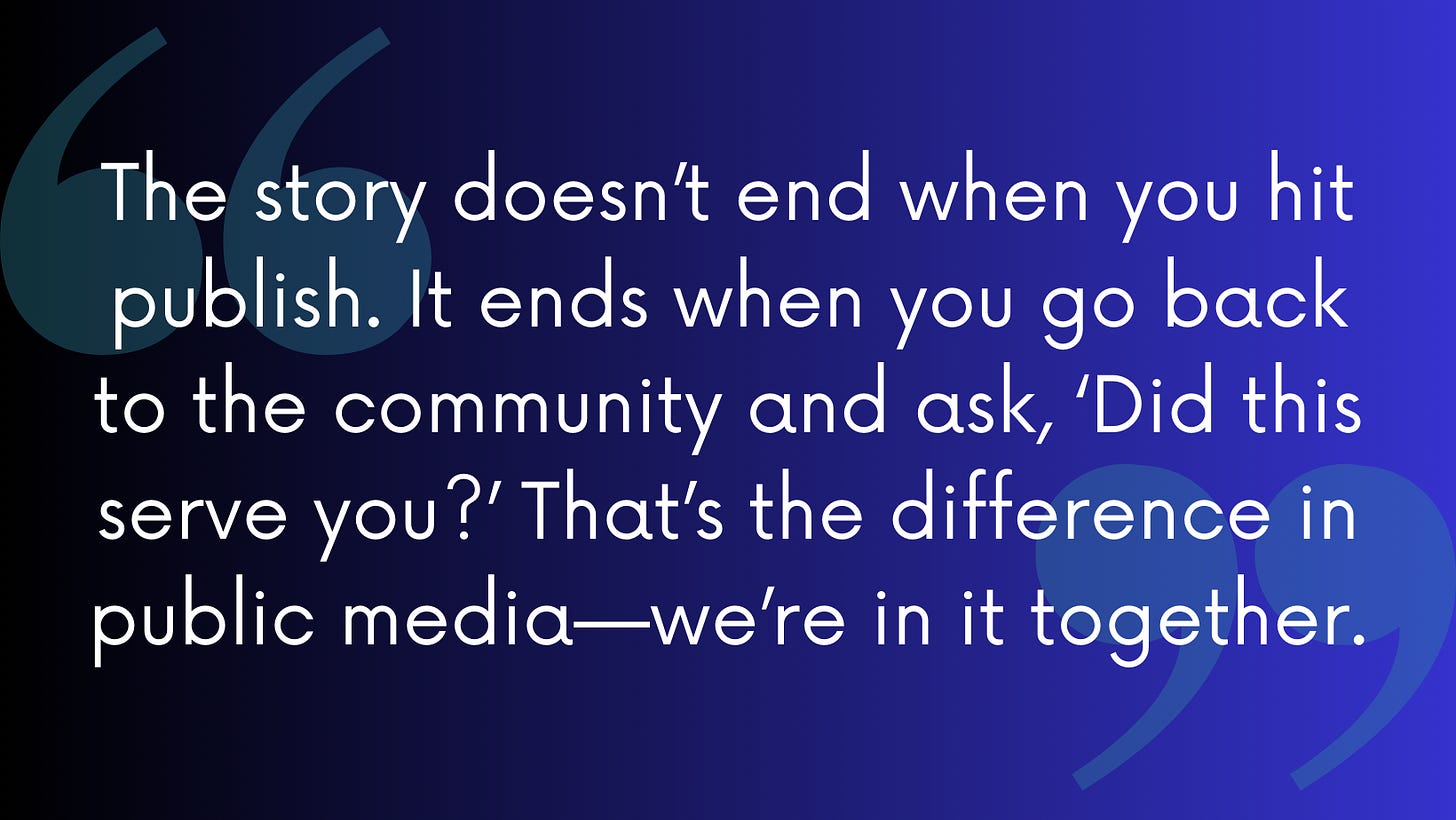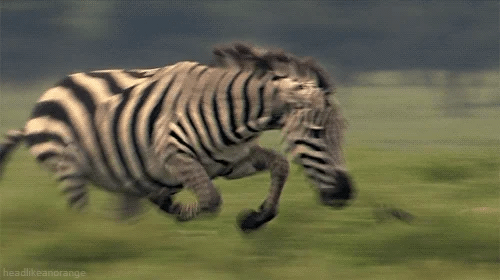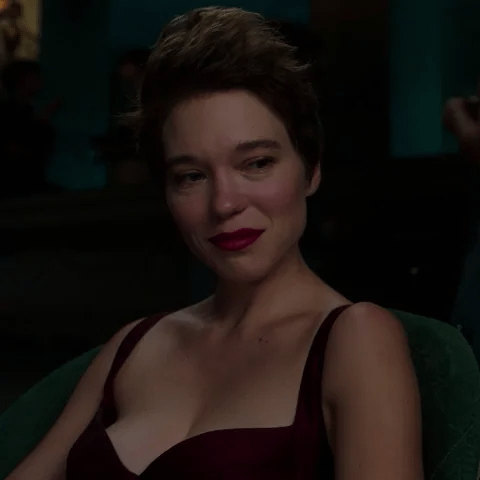Rooted in stories, connected to Colorado
Gabriela Resto-Montero on complexity, joy and authenticity in public media journalism
When it comes to public media, stories have the power to inform, connect and honor a community's lived experience. Few understand that better than Gabriela Resto-Montero, whose career spans daily newsrooms in New York City to her current role as an editorial leader at Rocky Mountain Public Media. Born in Puerto Rico and raised in Colorado, her personal and professional journey weaves through questions of identity, representation and the power of storytelling to reflect communities in all their complexities.
In this conversation, Resto-Montero shares how her family’s move to Colorado in the early 1990s shaped her understanding of belonging—and how her return to Denver, after years in New York media, revealed a changed city with new opportunities for community-centered journalism. At RMPM, she’s committed to fostering storytelling that goes beyond stereotypes, bringing nuance, joy and depth to Latino representation on-air and online.
Resto-Montero is the journalism director at Rocky Mountain PBS. She started her journalism career in the fifth grade as part of Rocky Mountain PBS’s Super School News and went on to study journalism at the University of Colorado, Boulder. Over a nearly 20 year career, she worked at The New York Daily News and NBC News, among others. As a freelance journalist she covered the Latino community, reproductive rights, politics and pop culture at places such as Cosmopolitan, Mic and Forbes.
Gabriela Resto-Montero’s reflections offer a reminder of why public media matters now more than ever: in showing up for communities, listening deeply, and telling stories that celebrate the fullness of people’s lives. 👇🏽
You’ve had quite a journey from Puerto Rico to Colorado, then New York, and back to Colorado. Can you talk about how that shaped your path to Rocky Mountain Public Media?
Absolutely. It was kind of a quirky family decision that led us here. In the early 1990s, Puerto Rico was going through one of its financial crises—unfortunately, the first of many—and my parents, like many others, were looking for opportunities. My mom’s side of the family did a ton of research on where to move, looking for good schools, jobs and a beautiful place to raise a family.
They narrowed it down to three places: Washington State, Arizona and Colorado. My dad and uncles did scouting trips to each, and they ultimately chose Colorado. We moved here from Guaynabo in 1993. But what they didn’t consider was whether there was a Puerto Rican community outside of our family—and at that time, the answer was no. Colorado had (and still has) a large Latino population, but it’s historically been predominantly Mexican American. So, for us, it was a big adjustment.
Growing up here, there was definitely a steep learning curve. In Puerto Rico, you’re just Ernesto or Gabriela—there’s no need to explain who you are. Here, you suddenly became “the Puerto Rican kid,” and that was new for all of us.
After college, you moved to New York. What was that experience like?
I graduated from CU Boulder and moved to New York City, where I lived for many years. It was eye-opening to be in a place with such a strong and historic Puerto Rican community. I remember being at a party and telling someone I was Puerto Rican, and he looked at me—this very New Yorker moment—and said, “You’re like a fly white girl!” I was wearing a fleece, so I get it! But New York was different. The visibility, the history and the pride in Puerto Rican identity were all around.
I worked in media there—at the New York Daily News and NBC. It was fast, intense, and eventually, I burned out. I started freelancing to get back to stories I cared about, and that really restored my love for journalism.
So how did you end up back in Colorado and at Rocky Mountain Public Media?
After years in New York, I moved back to Denver with my husband and kids, hoping life might be a little easier. Denver had changed a lot—there was so much more development, and to my surprise and joy, a much larger Puerto Rican community. My mom went to a doctor who was Puerto Rican, and she was so excited—she hadn’t met a Puerto Rican doctor here since we moved.
When I got back, I knew I wanted to return to a newsroom, but only if it aligned with the values I’d cultivated as a freelancer. Public media was the only space I looked at. And Rocky Mountain Public Media? I have a personal history with them. As a kid, I was an anchor on their school news show—it was my first experience in journalism. So when the job opened, I applied within an hour. They called me for an interview almost immediately. It all came full circle.
What excites you most about your work now?
The work itself is incredible. We have the freedom to take our time with stories, to explore video, audio and digital formats. We cover everything from ecological stories about Colorado’s parks to deep community profiles.
But what I love most is working with journalists—developing their stories, strategizing coverage, and mentoring. In public media, resources are precious. So, we have to be thoughtful: where do we go? Who aren’t we talking to? How do we support reporters to tell authentic stories? That process, every day, is what I love.
What has leadership been like for you?
I’ve been in journalism for about 20 years. Many journalists of color I started out with aren’t here anymore. Burnout, frustration, financial barriers—they’re real. But we need more Latinas, more journalists of color, in leadership roles where we can make decisions that reflect our communities in their fullness.
When we bring different perspectives to the table, we create a richer, more accurate picture of the world. That’s not abstract—it’s the work we do every day. And I’m incredibly grateful to be doing it.
You’ve also become an on-air presence. What does that representation mean for you?
It’s a huge privilege. Last year, for National Latina Day, we did a video featuring all the Latinas who work here. Seeing us all together, celebrating each other—it reminded me what an honor it is to be in this role. I get to help shape how our communities are portrayed in media.
Representation matters. I’m always asking: Are Latinos only showing up in our stories as immigrants? Are we only talking about deficits in education? That’s not the whole story. There’s joy, love and complexity in our communities. One story that stands out was about a Paletero art exhibit. It started as coverage of ICE raids but became a celebration of community resilience and culture. That’s the kind of storytelling we need—where we show people as whole human beings, not just through the lens of struggle.
You mentioned changes in Colorado’s Latino community. What stands out to you?
There’s been tremendous growth and diversification. More Caribbean folks are here now, and Denver’s a sanctuary city, so we’ve seen a growing Venezuelan community as well. The Mexican American community has deep roots here—families who’ve been in Colorado for generations—and now, new arrivals are adding layers to that story.
What’s fascinating is how we all come together under the term “Latino,” even though our experiences are so different. We’re constantly figuring out what that means and who we are to one another. It’s beautiful and complex.
In your view, what does public media need to do better to engage these communities?
We need to stop treating Latino communities as a monolith. Immigration isn’t the only story, even for those who are immigrants. We need to cover the full range of experiences and acknowledge the diversity within these communities—linguistically, culturally, economically.
Public media has the responsibility to go deeper. To show complexity. To portray people not just as victims or heroes, but as whole individuals. You don’t need to be perfect to deserve dignity and respect in our coverage.
What would you tell yourself before starting this job—knowing what you know now?
I’d tell myself that the story doesn’t end when you hit publish. It ends when you go back to the community it was written for and ask, “Did this serve you? Was it relevant?” That’s the difference in public media—there’s an ongoing relationship with the community. It’s energizing and respectful, and it makes for more honest journalism. 🟢
Cafecito: stories to discuss ☕
Pew Research has new polling on Americans’ support for public broadcasting. 🔢
Poynter spotlights criticism of the Philadelphia Inquirer over the closing of its community desk. That engagement initiative was launched three years ago to better reach traditionally underserved communities. 🧵
New research highlights Latinas’ giving interests and reasoning. While this is positioned mostly around campaign contributions, it may be instructive for your own development efforts. 🎱
Also not public media specific but relevant, CUInsight, which covers the credit union industry, drops insights and data around how engaging Hispanics can yield greater brand loyalty and investment. 🏛️
An interesting look from the Columbus Dispatch goes behind the scenes of an Ohio station’s format change from three decades of alternative rock to regional Mexican. 🎛️ Turns out, it’s part of a broader lease agreement.
Of interest to your politics journalists: Luz Media reports that the National Association of Latino Elected and Appointed Officials has chosen new leadership. 🔋
El radar: try this 📡
Bring Latino developing stories to your podcasts. KOSU shares a report on immigrant community fears amid ICE crackdowns. Focus features some Spanish narrative translated to English. 🫸
A similar story by Utah Public Radio is also worth noting.
Ask about Latino/a philanthropy. This WGBH story on the power of area Hispanic foundations and funders on the area’s life is one that bears telling everywhere. 👌
Dig into Hispanic business growth. Also at WGBH, a new local report indicates how much Latinx entrepreneurship is spiking right now in the state. 🏢 I think it could be a really compelling story to localize.
Explore Latine culinary programs. I found a recent KXAS piece on a culinary arts school’s Latino cooking discipline to be quite informative, and you might too. Given the explosion of Hispanic-themed restaurants, instruction to help the next generation of chefs serving these establishments could be happening in your community. 🍅
See how lawmakers are talking about immigration legislation amid Latino voter engagement. Lakeshore Public Radio, the Georgia Recorder and Source New Mexico offer an interesting dialogue among representatives about statewide bills targeting immigrants. 🎯 Are your leaders presenting their perspectives similarly?
The next OIGO arrives Apr. 11. My colleague Ethan Toven Lindsey and I will be presenting April 17 on AI for journalists and content creators — ways we’re using it to make our work better. I’m apparently the first three-peat Public Media Innovators guest, which is an honor! Register here to attend.







